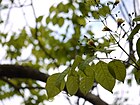Note: This is a project under development. The articles on this wiki are just being initiated and broadly incomplete. You can Help creating new pages.
Difference between revisions of "Stereospermum chelonoides - Patala"
(Created page with "thumb|right|''Patala'' '''Abrus precatorius''' is a severely invasive plant in warm temperate to tropical regions, so much so that it ha...") |
(→Commonly seen growing in areas) |
||
| Line 56: | Line 56: | ||
==Commonly seen growing in areas== | ==Commonly seen growing in areas== | ||
| − | {{Commonly seen| | + | {{Commonly seen|Moist parts}}, {{Commonly seen|Deciduous forests}}, {{Commonly seen|Humid climate}}, {{Commonly seen|Hot climate}}, {{Commonly seen|Lateritic loamy soils}}, {{Commonly seen|Sandy black soils}}. |
==Photo Gallery== | ==Photo Gallery== | ||
Revision as of 17:54, 25 September 2018
Abrus precatorius is a severely invasive plant in warm temperate to tropical regions, so much so that it has become effectively pantropical in distribution. It had been widely introduced by humans, and the brightly coloured and hard-shelled seeds had been spread by birds.
Contents
- 1 Uses
- 2 Parts Used
- 3 Chemical Composition
- 4 Common names
- 5 Properties
- 6 Habit
- 7 Identification
- 8 List of Ayurvedic medicine in which the herb is used
- 9 Where to get the saplings
- 10 Mode of Propagation
- 11 How to plant/cultivate
- 12 Commonly seen growing in areas
- 13 Photo Gallery
- 14 References
- 15 External Links
Uses
Indigestion, Hiccups, Vomiting, Diarrhea, Pain, Cough, Fever, Diabetes, Liver disorders, Asthma, lower blood sugar, Cholesterol, Parkinson's disease.
Parts Used
Chemical Composition
Common names
| Language | Common name |
|---|---|
| Kannada | adri, bilee paadari, billa |
| Hindi | pad, padal, padaria, padiala |
| Malayalam | kariyam, kuberakshi, padiri |
| Tamil | ambu, ambuvagini |
| Telugu | ambuvasini, kakkisa, kalagoru |
| Marathi | NA |
| Gujarathi | NA |
| Punjabi | NA |
| Kashmiri | NA |
| Sanskrit | abhipriya, alivallabha, ambuvasani |
| English | Adakapari, Bignonia chelonoides |
Properties
Reference: Dravya - Substance, Rasa - Taste, Guna - Qualities, Veerya - Potency, Vipaka - Post-digesion effect, Karma - Pharmacological activity, Prabhava - Therepeutics.
Dravya
Rasa
Guna
Veerya
Vipaka
Karma
Prabhava
Habit
Identification
Leaf
| Kind | Shape | Feature |
|---|---|---|
| Paripinnate | Oblong | Leaf Arrangementis Alternate-spiral |
Flower
| Type | Size | Color and composition | Stamen | More information |
|---|---|---|---|---|
| Unisexual | 2-4cm long | pink | Flowering throughout the year and In terminal and/or axillary pseudoracemes |
Fruit
| Type | Size | Mass | Appearance | Seeds | More information |
|---|---|---|---|---|---|
| oblong pod | Thinly septate, pilose, wrinkled | seeds upto 5 | Fruiting throughout the year |
Other features
List of Ayurvedic medicine in which the herb is used
Where to get the saplings
Mode of Propagation
How to plant/cultivate
Commonly seen growing in areas
Moist parts, Deciduous forests, Humid climate, Hot climate, Lateritic loamy soils, Sandy black soils.
Photo Gallery
- Ambuvasini (Telugu- అంబువాసిని) (7260565520).jpg 4,000 × 3,000; 4.95 MB
References
External Links
- Pages with broken file links
- Ayurvedic Herbs known to be helpful to treat Indigestion
- Ayurvedic Herbs known to be helpful to treat Hiccups
- Ayurvedic Herbs known to be helpful to treat Vomiting
- Ayurvedic Herbs known to be helpful to treat Diarrhea
- Ayurvedic Herbs known to be helpful to treat Pain
- Ayurvedic Herbs known to be helpful to treat Cough
- Ayurvedic Herbs known to be helpful to treat Fever
- Ayurvedic Herbs known to be helpful to treat Diabetes
- Ayurvedic Herbs known to be helpful to treat Liver disorders
- Ayurvedic Herbs known to be helpful to treat Asthma
- Ayurvedic Herbs known to be helpful to treat lower blood sugar
- Ayurvedic Herbs known to be helpful to treat Cholesterol
- Ayurvedic Herbs known to be helpful to treat Parkinson's disease
- Herbs with Seeds used in medicine
- Herbs with stem used in medicine
- Herbs with leaves used in medicine
- Herbs with Root used in medicine
- Herbs with common name in Kannada
- Herbs with common name in Hindi
- Herbs with common name in Malayalam
- Herbs with common name in Tamil
- Herbs with common name in Telugu
- Herbs with common name in Sanskrit
- Herbs with common name in English
- Habit - Tree
- Index of Plants which can be propagated by Seeds
- Herbs that are commonly seen in the region of Moist parts
- Herbs that are commonly seen in the region of Deciduous forests
- Herbs that are commonly seen in the region of Humid climate
- Herbs that are commonly seen in the region of Hot climate
- Herbs that are commonly seen in the region of Lateritic loamy soils
- Herbs that are commonly seen in the region of Sandy black soils
- Herbs





